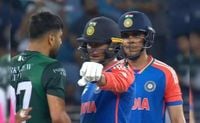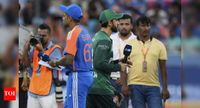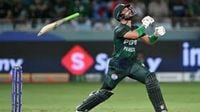The Asia Cup 2025 Super Four clash between India and Pakistan in Dubai on September 21 delivered everything fans have come to expect from cricket’s most storied rivalry—thrilling performances, simmering tensions, and off-field drama that spilled into the headlines. In front of a packed Dubai International Stadium, India extended their remarkable dominance over Pakistan, securing a six-wicket victory and notching their seventh consecutive win in completed matches against their arch-rivals across formats.
The contest began with high anticipation, shadowed by recent controversies. The now-infamous handshake row—where Indian players declined the customary post-match gesture with their Pakistani counterparts—remained unresolved. Once again, after the final ball, players from both sides refrained from shaking hands, keeping the issue firmly in the spotlight. The tension was palpable, not just among the players but in the stands and across social media, as fans debated the implications of what many see as more than just a snub.
The match itself was a showcase of high-octane cricket. Pakistan, batting first, posted a competitive 171 for 5 in their 20 overs. Sahibzada Farhan anchored the innings with a composed 58, while the middle order chipped in to keep the scoreboard ticking. India’s fielding, however, left much to be desired—four catches were dropped, and ace pacer Jasprit Bumrah endured a rare off day, conceding 45 runs. Still, crucial breakthroughs from Shivam Dube, who finished with figures of 2 for 33, helped prevent Pakistan from running away with the game. Kuldeep Yadav’s wrist spin also pegged back the scoring during the crucial middle overs.
Pakistan’s innings was not without drama. The openers started briskly, with Fakhar Zaman attacking from the outset before falling to Hardik Pandya, who set a record for the most wickets by a bowler in India-Pakistan T20Is with his 15th scalp. Saim Ayub and Farhan built a solid 72-run partnership, threatening to put India on the back foot. But a spate of wickets in the middle overs, including a smart catch by Abhishek Sharma to dismiss Ayub, helped India regain control. A late cameo by Faheem Ashraf, including a six off the final over, pushed Pakistan to what former Pakistan legend Wasim Akram called "the average winning score here in Dubai."
India’s chase began with a bang. Abhishek Sharma, who would later be named Player of the Match, set the tone by pulling Shaheen Afridi for a six off the very first ball. Sharma’s intent was unmistakable—he raced to his half-century in just 24 balls, peppering the boundary with five sixes and six fours in a blistering 74 off 39 deliveries. Alongside Shubman Gill, who contributed a fluent 47 off 28, the duo put on a 100-plus run opening stand that nearly sealed the game before the halfway mark. Their partnership was a study in contrast: Sharma’s aggression and Gill’s elegant shot-making kept the required rate in check and the Pakistani bowlers under relentless pressure.
The heat of the rivalry was evident not just in the scoreboard but in the exchanges on the field. Shaheen Afridi and Haris Rauf attempted to unsettle the Indian openers with sledging, but Sharma and Gill responded in kind, refusing to back down. "Today was pretty simple, the way they were coming out to us without any reason, I did not like it at all. That's why I went after them. I wanted to deliver for the team," Sharma said after receiving his Player of the Match award. His fearless approach epitomized the new generation of Indian cricketers—confident, unfazed, and determined to make a mark on the biggest stage.
As wickets fell, with Gill, Suryakumar Yadav, and Sanju Samson departing in quick succession, Pakistan sensed an opening. But the required rate was never out of reach. Tilak Varma and Hardik Pandya calmly knocked off the remaining runs, with Varma finishing the game in style—first with a towering six and then a boundary off Shaheen Afridi to seal the win with seven balls to spare.
India’s captain Suryakumar Yadav was effusive in his praise for the team’s resilience and composure. "The way the boys are stepping up in every game, it's making my job very easy. The boys showed a lot of character. They were calm after the first 10 overs. After drinks, I told them the game starts now. That's fine, he's not a robot, he will have a bad day someday (talking about Bumrah). Dube bailed us out of the situation. They complement each other really well (Abhishek and Gill). It's like a fire and ice combination," Yadav remarked in the post-match presentation.
On the other side, Pakistan captain Salman Agha acknowledged his team’s shortcomings but found positives to build on. "We are yet to play a perfect game, but we are getting there. A great game but in the powerplay they took the game away from us. After 10 overs, we could have got 10-15 more. 170-180 is a good total but in the powerplay they batted well, that was the difference. If you see the bowlers are going for runs, you need to change it, that's how it goes in T20s. There's a lot of positives—the way Fakhar batted, Farhan batted and Harry bowled," he reflected.
The match was not just about cricketing skills; it was also a microcosm of the larger narrative that has defined India-Pakistan cricket for decades. From the handshake controversies to the ever-present political backdrop, every encounter between these two teams is layered with history and emotion. The recent pattern of no handshakes, fueled by rain-affected misunderstandings and amplified by social media, has only added to the intrigue. Off the field, Pakistan’s decision to skip pre-match press conferences and the involvement of motivational speakers in their camp have drawn criticism and speculation, with former players like Sunil Gavaskar and Danish Kaneria weighing in on the state of affairs.
Meanwhile, India’s cricketing machinery continues to roll forward. With seasoned stars like Rohit Sharma and KL Rahul working on their comebacks at the BCCI Centre of Excellence, and administrative changes on the horizon with former Delhi captain Mithun Manhas set to become the new BCCI president, the team’s focus remains sharp. Young talents like Abhishek Sharma are stepping up, turning high-pressure games into personal milestones and collective triumphs.
As the dust settles on another memorable India-Pakistan encounter, the talking points extend well beyond the boundary ropes. India’s clinical chase, Pakistan’s flashes of brilliance, and the ongoing handshake saga ensure that the rivalry remains as compelling as ever. With more matches ahead in the Super Four stage, fans can only expect the drama—and the cricket—to intensify.
For now, India’s players and supporters will savor a hard-fought win, while Pakistan look to regroup and address both their on-field execution and off-field distractions. One thing’s certain: when these two giants meet, the world watches, and the story is never just about the runs and wickets.






